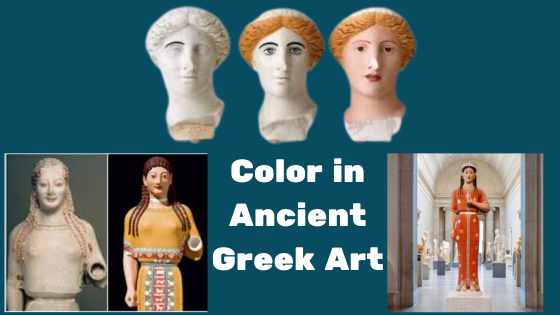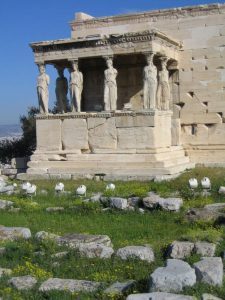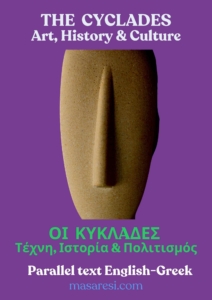The Role of Color in Ancient Greek art
When we think about ancient Greek art, the image that often comes to mind is of white, polished statues and big, shiny temples. This is the classic image that has been passed down through history. However, recent discoveries have dramatically changed this view. Scientists and archaeologists have uncovered traces of color on many ancient Greek objects, revealing that the art was not only white but also vibrant and full of life.
The Colorful Statues of The Past
One of the most notable examples of this are the kores, large statues of young women from the 6th century B.C.
These statues, which are displayed at the Acropolis Museum in Athens, were originally painted in bright colors, although much of this color has faded over time.
It’s not just the statues that were colorful—ancient buildings like the Parthenon also featured painted details that have since disappeared.
These new findings show that ancient Greek art, in its original form, was a much more colorful world than the white stone we see today.
 If you have not visited the Acropolis museum yet, then add it to your “to-visit-list”!
If you have not visited the Acropolis museum yet, then add it to your “to-visit-list”!
More info here; https://omilo.com/the-acropolis-museum-in-athens-its-past-and-present/
The Rediscovery of Color in Ancient Art
For many years, scholars and visitors believed that the ancient Greek sculptures were white and unpainted, as we see them in museums today. However, new research has shown that this is not the case. Experts from Harvard University and other institutions have used advanced techniques, such as spectrometry, to uncover traces of color on ancient Greek statues. For example, the famous Cycladic figures, which are known for their simple and abstract forms, were originally painted with details such as eyes, eyebrows, and even crowns.
The use of technology has allowed scientists to detect faint chemical traces of the original colors, revealing much more about these statues than we previously knew.
The Significance of Color in Ancient Greek Art
Some of the most fascinating discoveries have come from the analysis of Cycladic figures. These statues, often made of marble, originally featured painted eyes, mouths, and eyebrows. Experts have even identified patterns, such as dots on the forehead and cheeks, that suggest the statues may have represented people with painted or decorated bodies. This leads to a new theory: perhaps ancient Greek people, or at least the people who created these statues, had a tradition of painting their bodies, or even tattooing them, as part of their cultural practices. While we do not have direct historical evidence of body painting or tattoos in ancient Greece, it is known that ancient societies, including the Greeks, used body decoration as a form of self-expression, ritual, and social status. Jewelry, body paint, and tattoos were common throughout ancient history, and this tradition continues in many cultures today.
Color: An Integral Element of Expression
The discovery that ancient Greek sculptures were painted is not just a fascinating insight into the past—it also changes the way we understand these works of art. For years, the simplicity of the white marble statues seemed to suggest a focus on beauty and perfection through form alone. However, with the revelation that these statues were painted, it becomes clear that color played a crucial role in ancient Greek art. The colors added a layer of meaning and expression that was lost to history.
For instance, the kores statues that were originally painted in bright red, blue, and green were not just representations of idealized beauty but were, in a sense, depicting life itself. The bright colors would have made the figures appear more human, adding details that highlighted their facial features, clothing, and even jewelry. This suggests that the ancient Greeks used color as an essential element of expression, much as we do today with clothing, makeup, or accessories.
The Parthenon: A Colorful Masterpiece
In addition to these painted figures, the Parthenon, one of the most iconic Greek temples, was also originally painted in vivid colors. The temple’s sculptural decoration, including the famous Parthenon Marbles, was painted with rich colors. While this fact has been known for some time, the recent technology used to uncover traces of paint has helped experts understand just how important color was in creating the visual impact of the temple.
These findings show that painting was not merely decorative; it was integral to how the Greeks experienced and understood their art and architecture.
New Insights into Ancient Greek Life
The rediscovery of color in ancient Greek art is also shedding light on ancient Greek society and daily life. For example, scientists recently uncovered evidence of copper production on Daskalio, a small island in Greece, close to bigger island Naxos. They found holes in the ground where copper was melted, suggesting that the island was used for manufacturing tools and weapons. These discoveries, combined with the information about colored statues, help us understand that the ancient Greeks were not just artists—they were also skilled in technology and craftsmanship, and their art was intertwined with their daily activities.
Would you like to learn more about Daskalio and Cycladic Greek art?
–>then this eBook is ideal for you 🙂
Note;
This eBook is written in English and Greek,
so for advanced students, also perfect to improve your Greek reading skills, and vocabulary
The Role of Color in Cultural Identity
The use of color also suggests that the ancient Greeks may have had more complex social and cultural practices than we had previously imagined. For example, the painted details on statues could have signified different things depending on the community or region. Different groups might have had their own traditions of painting their statues or even their bodies, much like how different cultures today use colors to represent certain identities or ideas. The idea that each family or group had its own way of painting their statues adds a personal, almost family-like touch to these works of art.
A New Perspective on Ancient Art
These discoveries also remind us that the past is often more colorful and complex than we realize. What we see today is only a fragment of the true picture of ancient life. By using modern technology to uncover traces of paint and other materials, we can begin to imagine what life was really like for the people who created these masterpieces. The color of ancient Greek art not only brings the statues and buildings to life but also helps us connect with the people who made them.
Conclusion: A Colorful Legacy
For many centuries, we have admired the beauty of ancient Greek art in its white, marble form. But with the discovery of color on sculptures, statues, and buildings, we now understand that these works of art were not just plain stone, they were vibrant, expressive, and full of life. The use of color in ancient Greece was not only about beauty but also about cultural identity, social status, and human expression. These new findings invite us to look at ancient art with fresh eyes and offer a deeper connection to the past, showing us a more colorful and complex world than we ever imagined.
+++++++++++++++++++++++++
PS. Do not forget to also read this article in Greek and listen to the Greek audio, to improve your listening skills.
++++++++++++++++++++++++++++++
Do you also want to learn more about amazing Greek Archaeological Sites?
Then click below for more info about one more interesting eBook, written in English and Greek









